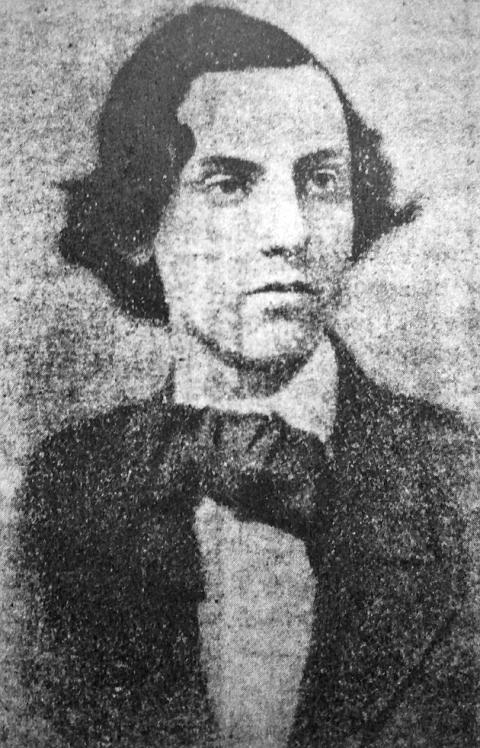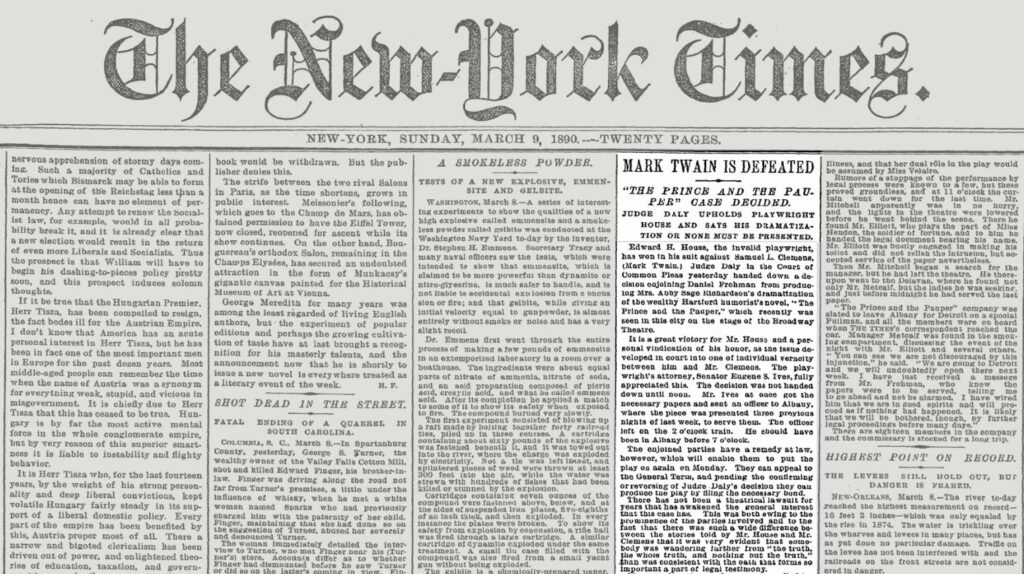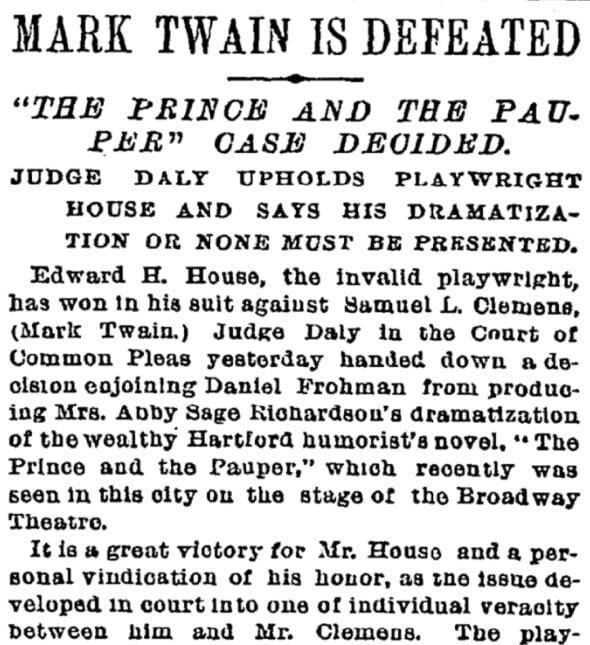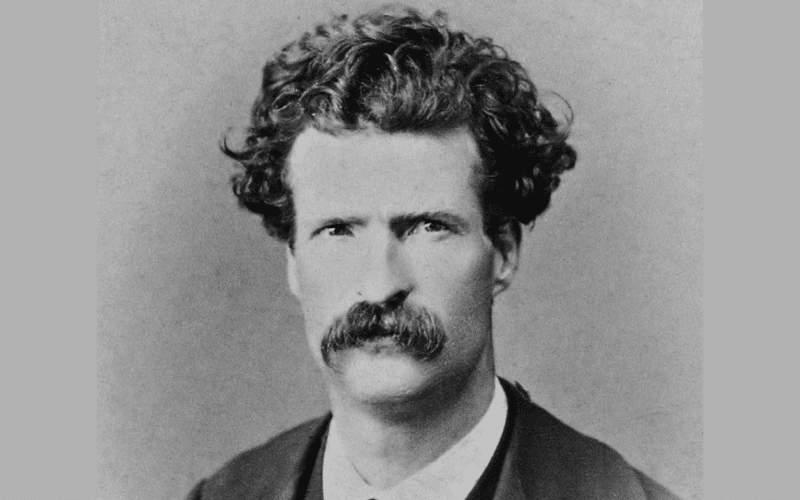More than a century before feuds over kidney donation stories captivated the internet, Mark Twain and his friend Edward House battled over a stage adaptation of “The Prince and the Pauper.”
If you have a subscription to The New York Times—or frankly, any sort of internet access whatsoever—you’ve no doubt heard by now about the “Bad Art Friend.” The dispute between writers and former friends Sonya Larson and Dawn Dorland over a short story involving a kidney donation has captured the attention of social media during the past week. There’s something about friends fighting over plagiarism allegations that piques our basest voyeuristic tendencies—especially when the feud is accompanied by gossipy invective spewed out in group chats and private Facebook groups.
But as far as snide comments and behind-the-back drama are concerned, the Larson/Dorland squabble can’t hold a candle to another battle waged in both the press and the courts between two writers and soon-to-be former friends in the late 1800’s. At least one of them you’ve heard of—Samuel Clemens, better known to his fans and critics by the pen name Mark Twain.
“The Prince and the Pauper”
The art at issue was Twain’s 1881 novel “The Prince and the Pauper,” the story of two boys—one a poor beggar and the other the son of King Henry VIII—who exchange roles. (Even if you haven’t read the book, you’re probably familiar with the general plot, which has loosely inspired countless films including “Trading Places.”)
By 1884, Twain had already tried to dramatize “The Prince and the Pauper” for the stage, but it was proving to be a difficult task for the novelist. Enter Edward Howard House, a longtime friend of Twain’s who had been a journalist for the New York Tribune.

When the two writers first met in 1867, Twain would describe House as being “brisk, handsome and polished and engaging in his manners.” However, after years of litigation, House would become, in Twain’s words, a “liar,” a “barking dog” and a “polecat”—which I assume in the late 1800’s would have been worse than Sonya Larson calling Dawn Dorland a “Karen.”
To Dramatize a Novel
But let’s not get ahead of ourselves. In the beginning, everything was copacetic between Mark Twain and Edward House. The relationship was certainly a bit skewed by nature. Twain, as the country’s most famous author and a millionaire, was the prince to House’s pauper. An invalid, House was disabled by gout and confined to his bed or a wheelchair.
While bedridden, House read a version of “The Prince and the Pauper” while it was still in manuscript form, and expressed interest in adapting it for the stage. In a December 17, 1887 letter, Twain agreed to allow House to do so:
“You have spoken of ‘The Prince and the Pauper,’ for the stage. That would be nice, but I cannot dramatize it. The reason I say this is because I did dramatize it and made a bad botch of it, but you could do it, and if you will take one-half or two-thirds of the proceeds, I wish you would. Shan’t I send you the book?”
Mark Twain to Edward House, December 17, 1887
House responded on December 24, 1887 that he would be “well pleased to undertake the dramatization” of Twain’s book, and offered a then-ingenious solution to deal with the stage arrangements—both main characters, who looked nearly identical in the novel, would be played by the same actor. (House’s simple stroke of genius would help ensure that Hayley Mills and Lindsay Lohan could each demand more money for their dual-role performances in “The Parent Trap” films decades later.)
The Silent Treatment
Over the course of additional correspondence and a meeting in New York, House claimed that Twain agreed that House would receive half the proceeds from the “Prince and the Pauper” dramatization. House continued to plot out the play and had it finished by the second half of 1887. That’s when Mark Twain went radio silent, failing to respond to House’s correspondence over the course of more than a year. Finally, in February 1889, House wrote to Twain about a rumor he had heard that Twain was occupying himself with the dramatization of one of his books, and called Twain’s attention to their unfinished business on “The Prince and the Pauper.”
Much like “Bad Art Friend’s” Sonya Larson initially avoided Dawn Dorland before turning defensive at the mere suggestion that she’d done anything wrong, Twain finally replied to House on February 26, 1889:
“I gather the idea from your letter that you would have undertaken the dramatization of that book. Well, that would have been joyful news to me about the middle of December, when I gladly took the first offer that came, and made a contract. I remembered that you started once to map out the framework for me to fill in and I suggested to this lady that possibly you would collaborate with her, but she thought she would do the work alone.”
Mark Twain to Edward House, February 26, 1889
Another Direction
“This lady” was Abby Sage Richardson, a writer whom Twain had subsequently enlisted to dramatize “The Prince and the Pauper.” Richardson would cast popular child actress Elsie Leslie as the star in the dual roles of the prince and the pauper, and House was cut out.
Richardson’s dramatization, under the supervision of New York theater producer Daniel Frohman, was first performed in Philadelphia on Christmas Eve, 1889. In Richardson’s dramatization, the principal characters of “The Prince and the Pauper” are performed by one person, as suggested by House.

Contract? What Contract?
In a pique of Larson-style gaslighting, Twain thereafter pleaded ignorance of any contract with House. This prompted House to obtain a copyright registration on his dramatization in 1889 and thereafter to file a lawsuit against Twain, Richardson and Frohman in January 1890. In addition to a claim for breach of contract against Twain, House argued that all of the defendants had wrongfully appropriated his idea of using one actor for the parts of both prince and pauper and had also lifted certain scenes from House’s dramatization.

The “stolen ideas” lawsuit, captioned House v. Clemens, captivated the country’s attention like no literary feud before it. As The New York Times described it, “There has not been a theatrical lawsuit for years that has awakened the general interest that this case has. This was both owing to the prominence of the parties involved and to the fact that there was such a wide difference between the stories told by Mr. House and Mr. Clemens that it was very evident that somebody was wandering farther from ‘the truth, the whole truth, and nothing but the truth,’ than was consistent with the oath that forms so important a part of legal testimony.”
“A more unequal contest could scarcely be imagined. On the one side the most popular author of the day, in the flush of active health and strength, with unbounded resources of influence, wealth and established position. On the other, a well-nigh forgotten writer, condemned by illness to years of seclusion, crippled by a torturing disease…”
Edward House, Letter to the Editor, The New York Times, January 31, 1890
He Said-He Said
For his part, Twain admitted that he previously had some discussions with House about adapting his novel, but claimed that everything was very general. House was only to try his hand at a dramatization, and Twain never gave House any exclusive right to do so. Twain claimed that no contract was ever made between the two of them, and while House had drawn up a skeleton of the first act, there was no agreement that House would have the exclusive right to dramatize the book. “It was simply experimental,” explained Twain. Twain asserted that House had lost interest after that, and that the project had come to an end.
Twain claimed he hadn’t heard anything at all about the matter from House until after he had given Abby Sage Richardson permission to dramatize the book. He also rejected the notion that House had come up with the idea of having the two main roles played by one actress, claiming that the suggestion had been made by Twain’s friend William Gillette three years earlier.

In a fascinating letter to the editor published in the January 31, 1890 edition of The New York Times, House responded to an interview Twain had given to a reporter for his hometown Hartford Courant (which had declined to publish House’s rebuttal):
“The assumption upon which the author of ‘The Prince and the Pauper’ relies for security throughout this extraordinary business is that of absolute and almost unqualified forgetfulness. What he does not remember covers a broad array of important events and documents. What he remembers more or less imperfectly is insignificant in comparison. That he remembers anything whatever with literal accuracy I have not yet been able to discover.”
Edward House, Letter to the Editor, The New York Times, January 31, 1890
Far from losing interest in the project, House claimed that he’d completed his agreement, but couldn’t get Twain to respond to his repeated correspondence after that. Two years later, “when it pleased [Twain] to break our contract, he gave me to understand that these transactions and the correspondence relating to them had entirely passed from his mind.”

The Court’s Ruling
The New York Times covered each new development in the legal saga, including the filing of House’s lawsuit up the court’s initial ruling (read here), which was rendered by New York Court of Common Pleas Justice Joseph F. Daly on March 8, 1890. The Times called the decision “uncompromisingly in favor of Mr. House . . . [and] exceedingly exhaustive.”

Justice Daly found that Twain’s letter of December 17, 1887 constituted “a distinct proposition to dramatize the work” and that House accepted it in his letter of December 24, 1887. As for the parties’ competing stories about what transpired thereafter, Justice Daly rather charitably surmised that Twain’s status as such a “busy and popular” author may have caused him to overlook details that “would not be forgotten by an invalid like the plaintiff, confined to his bed or chair, and conceded to be a man of methodical habits in recording the details of his correspondence or conversations.” The bottom line was that the court believed House over Twain.

Daly ended up issuing a preliminary injunction, not only against Twain, but also against Frohman and Richardson. While the defendants couldn’t be affirmatively compelled to use House’s dramatization of the story, neither were they permitted to use Richardson’s. With “The Prince and the Pauper” about to open in Detroit, Frohman was forced to reach an agreement with House. They settled on a deal that would allow Frohman to continue to produce the play for five years in exchange for giving House a percentage of the proceeds, with the remainder held in escrow until the Twain-House litigation had concluded.
“The thought that I could be thus betrayed by one who had for twenty-five years called himself my friend, and whom I held to be a man of honor, was too monstrous for credibility.”
Edward House, Letter to the Editor, The New York Times, January 31, 1890
The Aftermath
Through it all, Twain continued to maintain his own unique version of history, at one point rather incredibly claiming that House had never even thought about making a play out of his book until he heard that Abby Sage Richardson had done so. Twain denigrated House’s abilities as a writer, and his presence as Twain’s houseguest in 1887 was now characterized as an act of charity to a man with no other friends.
Further legal proceedings continued over the next few years, including a side-battle between Frohman and House after House staged his competing version of the play. But ultimately, House ended up moving to Japan, and the whole matter eventually fizzled out, with House’s lawyer dismissing the action against Twain. A chronicle of the litigation by William Manz in the Journal of the Copyright Society of the USA concluded that “What is certain about the Prince and the Pauper litigation is that it brought no benefit to either Twain or House, serving only to destroy their friendship.”
So the next time you end up sinking your teeth into a 10,000 word story like “Who is the Bad Art Friend?,” remember that bad art friends are just about as old as art and friends. I can only imagine the damage Twain and House could have done to each other if either had access to private Facebook pages or group chats.
As always, let me know what you think, either in the comments below or on your favorite social media platform @copyrighlately!
***Among the sources I consulted for this article (several of which unfortunately aren’t readily available via free services online), are: William H. Manz, Difficult Clients and Clashing Affidavits: The Prince and the Pauper Litigation, 55 J. Copyright Soc’y U.S.A. 623 (2007-2008); James L. Huffman, “A Yankee in Meiji Japan: The Crusading Journalist Edward H. House” (2003); Paul Fatout, Mark Twain: Litigant, 31 American Literature 30 (March 1959); House v. Clemens, 24 Abb. N.C. 381 (Ct. Common Pleas N.Y. County 1890); Mark Twain Day by Day; TwainQuotes.com; and the original newspaper articles cited within the post.***







2 comments
Great post Aaron!
Thanks for reading Larry! Would love to hear if you have any new topic suggestions that you think might be interesting!
Aaron